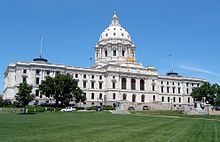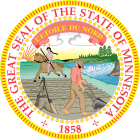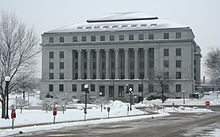- Minnesota Legislature
-
Minnesota Legislature 
Type Type Bicameral Houses Senate
House of RepresentativesLeadership President of the Senate Michelle Fischbach, Republican
since January 4, 2011Speaker of the House Kurt Zellers, Republican
since January 4, 2011Members 201 Political groups Minnesota Democratic-Farmer-Labor Party
Republican Party of MinnesotaElections Last election November 2, 2010 Meeting place 
Minnesota State Capitol, St. Paul, Minnesota Website http://www.leg.state.mn.us/ The Minnesota Legislature is the legislative branch of government in the U.S. state of Minnesota. It is a bicameral legislature located at the Minnesota Capitol in Saint Paul and it consists of two houses: the lower Minnesota House of Representatives and the Minnesota Senate. The House has 134 seats, the Senate has 67.
Early on in the state's history, the legislature had direct control over the city charters that set the groundwork for governments in municipalities across the state. In the early period, many laws were written for specific cities. The practice was outlawed in 1881, though attempts were still made. For instance, the long-standing Minneapolis Park Board and the city's Library Board were both created by the legislature in the next several years. The Minnesota State Constitution was amended in 1896 to give cities direct control over their own charters.
In 1913, Minnesota legislators began to be elected on nonpartisan ballots. Nonpartisanship was a historical accident that occurred when a bill to provide for no party elections of judges and city and county officers was amended to include the Legislature in the belief that it would kill the bill. Legislators ran and caucused as "Liberals" or "Conservatives" roughly equivalent in most years to Democratic or Farmer Labor (later Democratic-Farmer-Labor) and Republican, respectively. In 1974, House members again ran with party designation. In 1976, Senate members again ran with party designation.
In 1984 the Legislature ordered that all gender-specific pronouns be removed from the state laws. After two years of work, the rewritten laws were adopted. Only 301 of 20,000 pronouns were feminine. "His" was changed 10,000 times and "he" was changed 6,000 times.
The legislature oversees the funding for the University of Minnesota and Minnesota State Colleges and Universities (MnSCU) systems.
Former Governor Jesse Ventura advocated the idea of changing the legislature to a unicameral system while he was in office, but the concept did not obtain widespread support.
Minnesota 
This article is part of the series:
Politics and government of
MinnesotaConstitutionExecutiveLegislatureJudiciaryElectionsDivisionsFederal Relations
In 2004, the legislature ended its regular session without acting on a majority of the planned legislation, largely due to political divisiveness on a variety of issues ranging from education to same-sex marriage (See same-sex marriage in the United States for related events during the year). A proper budget failed to pass, and major anticipated projects such as the Northstar Corridor commuter rail line were not approved. Governor Tim Pawlenty, currently an advocate of the line (formerly an opponent), was expected to request a special session, but ended up helping the coordination of other funds to continue development of the line.
The lack of action in the 2004 session is said to be one reason why a number of Republican House members lost their seats in the November election. The Democratic-Farmer-Labor minority grew from 53 to 66 and the Republican majority was reduced from 81 to 68.
The Senate was not up for election in 2004 so the DFL was able to maintain its 5 seat majority in the upper house. One State Senator was an Independence Party member until December 2005, Sheila Kiscaden of Rochester, she caucuses with the DFL today, although she had been a Republican in the past. The DFL majority increased to six Senators when Sen. Kiscaden announced her re-affiliation with the DFL in preparation to run for Lieutenant Governor on a ticket with DFLer Kelly Doran.
There is a mandatory adjournment date specified in the state constitution: "The legislature shall not meet in regular session, nor in any adjournment thereof, after the first Monday following the third Saturday in May of any year." In 2005, the regular session ended without passage of an overall budget, and a special session opened. No overall budget passed by the end of the fiscal year on June 30, and much of the government shut down for the first time in state history. However, some essential services remained in operation, and some departments received funding in legislation. A compromise budget was approved and signed into law two weeks later, but state offices remained closed over a highly publicized and strongly criticized Fourth of July weekend.
When the legislature is in session, it is broadcast on television via KTCI channel 17 to the Twin Cities region.
External links
Members of the Minnesota State Senate 87th Legislature (2011-2012)
President of the Senate: Michelle Fischbach (R) • Majority Leader: Amy Koch (R) • Minority Leader: Tom Bakk (D)- LeRoy A. Stumpf (DFL)
- Rod Skoe (DFL)
- Tom Saxhaug (DFL)
- John Carlson (R)
- David Tomassoni (DFL)
- Thomas M. Bakk (DFL)
- Roger Reinert (DFL)
- Tony Lourey (DFL)
- Keith Langseth (DFL)
- Gretchen Hoffman (R)
- Bill Ingebrigtsen (R)
- Paul Gazelka (R)
- Joe Gimse (R)
- Michelle Fischbach (R)
- John Pederson (R)
- Dave Brown (R)
- Sean Nienow (R)
- Scott Newman (R)
- Amy Koch (R)
- Gary Kubly (DFL)
- Gary Dahms (R)
- Doug Magnus (R)
- Kathy Sheran (DFL)
- Julie Rosen (R)
- Al DeKruif (R)
- Mike Parry (R)
- Dan Sparks (DFL)
- John Sterling Howe (R)
- David Senjem (R)
- Carla Nelson (R)
- Jeremy Miller (R)
- Warren Limmer (R)
- Gen Olson (R)
- Julianne Ortman (R)
- Claire Robling (R)
- Dave Thompson (R)
- Chris Gerlach (R)
- Ted Daley (R)
- James Metzen (DFL)
- Dan Hall (R)
- Geoff Michel (R)
- David Hann (R)
- Terri Bonoff (DFL)
- Ron Latz (DFL)
- Ann Rest (DFL)
- Chris Eaton (DFL)
- Benjamin Kruse (R)
- Mike Jungbauer (R)
- Michelle Benson (R)
- Barb Goodwin (DFL)
- Pam Wolf (R)
- Ray Vandeveer (R)
- Roger Chamberlain (R)
- John Marty (DFL)
- Charles Wiger (DFL)
- Ted Lillie (R)
- Katie Sieben (DFL)
- Linda Higgins (DFL)
- Lawrence Pogemiller (DFL)
- D. Scott Dibble (DFL)
- Jeff Hayden (DFL)
- Patricia Torres Ray (DFL)
- Ken Kelash (DFL)
- Dick Cohen (DFL)
- Sandy Pappas (DFL)
- Mary Jo McGuire (DFL)
- John Harrington (DFL)
Republican (37) • Democratic-Farmer-Labor (29) • Vacant (1) • Minnesota Legislature • Minnesota House of Representatives • Minnesota State SenateMembers of the Minnesota House of Representatives 87th Legislature (2011-2012)
Speaker of the House: Kurt Zellers (R) • Majority Leader: Matt Dean (R) • Minority Leader: Paul Thissen (D)- A. Dan Fabian (R)
B. Debra Kiel (R) - A. Kent Eken (DFL)
B. David Hancock (R) - A. Tom Anzelc (DFL)
B. Carolyn McElfatrick (R) - A. John Persell (DFL)
B. Larry Howes (R) - A. Tom Rukavina (DFL)
B. Carly Melin (DFL) - A. David Dill (DFL)
B. Mary Murphy (DFL) - A. Thomas Huntley (DFL)
B. Kerry Gauthier (DFL) - A. Bill Hilty (DFL)
B. Roger Crawford (R) - A. Morrie Lanning (R)
B. Paul Marquart (DFL) - A. Bud Nornes (R)
B. Mark Murdock (R) - A. Torrey Westrom (R)
B. Mary Franson (R) - A. John Ward (DFL)
B. Mike LeMieur (R) - A. Paul Anderson (R)
B. Bruce Vogel (R) - A. Tim O'Driscoll (R)
B. Larry Hosch (DFL)
- A. Steve Gottwalt (R)
B. King Banaian (R) - A. Sondra Erickson (R)
B. Mary Kiffmeyer (R) - A. Kurt Daudt (R)
B. Bob Barrett (R) - A. Ron Shimanski (R)
B. Dean Urdahl (R) - A. Bruce Anderson (R)
B. Joe McDonald (R) - A. Andrew Falk (DFL)
B. Lyle Koenen (DFL) - A. Chris Swedzinski (R)
B. Paul Torkelson (R) - A. Joe Schomacker (R)
B. Rod Hamilton (R) - A. Terry Morrow (DFL)
B. Kathy Brynaert (DFL) - A. Bob Gunther (R)
B. Tony Cornish (R) - A. Glenn Gruenhagen (R)
B. Kelby Woodard (R) - A. Kory Kath (DFL)
B. Patti Fritz (DFL) - A. Rich Murray (R)
B. Jeanne Poppe (DFL) - A. Tim Kelly (R)
B. Steve Drazkowski (R)
- A. Duane Quam (R)
B. Kim Norton (DFL) - A. Tina Liebling (DFL)
B. Mike Benson (R) - A. Gene Pelowski (DFL)
B. Greg Davids (R) - A. Joyce Peppin (R)
B. Kurt Zellers (R) - A. Steve Smith (R)
B. Connie Doepke (R) - A. Ernie Leidiger (R)
B. Joe Hoppe (R) - A. Michael Beard (R)
B. Mark Buesgens (R) - A. Mary Liz Holberg (R)
B. Pat Garofalo (R) - A. Tara Mack (R)
B. Kurt Bills (R) - A. Diane Anderson (R)
B. Doug Wardlow (R) - A. Rick Hansen (DFL)
B. Joe Atkins (DFL) - A. Pam Myhra (R)
B. Ann Lenczewski (DFL) - A. Keith Downey (R)
B. Pat Mazorol (R) - A. Kirk Stensrud (R)
B. Jenifer Loon (R)
- A. Sarah Anderson (R)
B. John Benson (DFL) - A. Steve Simon (DFL)
B. Ryan Winkler (DFL) - A. Sandra Peterson (DFL)
B. Lyndon Carlson (DFL) - A. Michael Nelson (DFL)
B. Debra Hilstrom (DFL) - A. Denise Dittrich (DFL)
B. Melissa Hortman (DFL) - A. Tom Hackbarth (R)
B. Jim Abeler (R) - A. Peggy Scott (R)
B. Branden Petersen (R) - A. Carolyn Laine (DFL)
B. Kate Knuth (DFL) - A. Tim Sanders (R)
B. Tom Tillberry (DFL) - A. Bob Dettmer (R)
B. Matt Dean (R) - A. Linda Runbeck (R)
B. Carol McFarlane (R) - A. Mindy Greiling (DFL)
B. Bev Scalze (DFL) - A. Leon Lillie (DFL)
B. Nora Slawik (DFL) - A. Kathy Lohmer (R)
B. Andrea Kieffer (R)
- A. John Kriesel (R)
B. Denny McNamara (R) - A. Joe Mullery (DFL)
B. Bobby Joe Champion (DFL) - A. Diane Loeffler (DFL)
B. Phyllis Kahn (DFL) - A. Marion Greene (DFL)
B. Frank Hornstein (DFL) - A. Karen Clark (DFL)
B. vacant - A. Jim Davnie (DFL)
B. Jean Wagenius (DFL) - A. Paul Thissen (DFL)
B. Linda Slocum (DFL) - A. Erin Murphy (DFL)
B. Michael Paymar (DFL) - A. Rena Moran (DFL)
B. Carlos Mariani (DFL) - A. John Lesch (DFL)
B. Alice Hausman (DFL) - A. Tim Mahoney (DFL)
B. Sheldon Johnson (DFL)
Republican (72) • Democratic-Farmer-Labor (62) • Minnesota Legislature • Minnesota House of Representatives • Minnesota State SenateCategories:- Government of Minnesota
- Minnesota Legislature
- Bicameral legislatures
Wikimedia Foundation. 2010.

